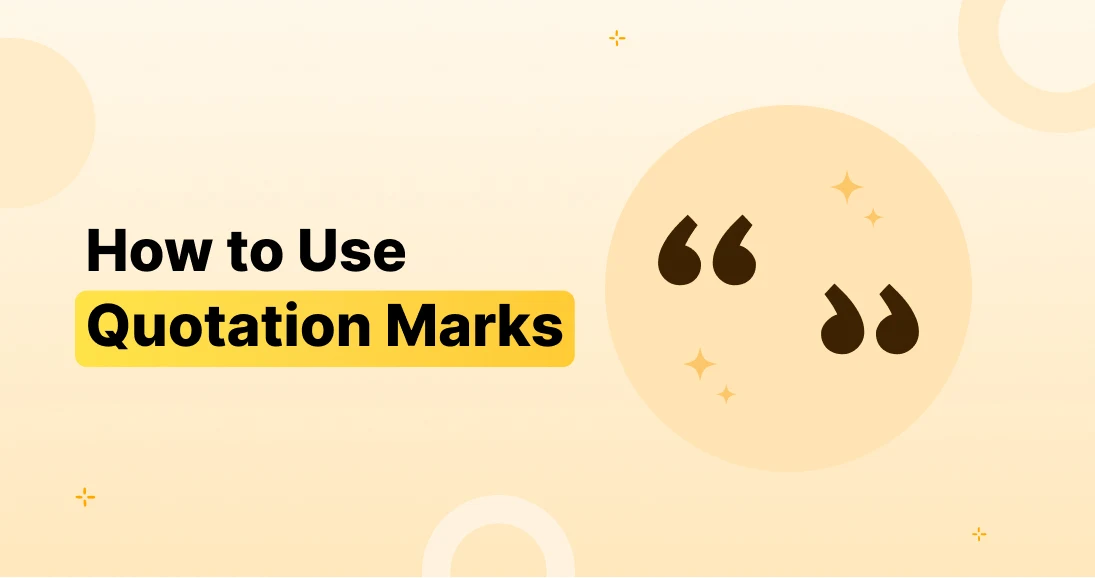Quotation marks might seem small, but their impact on clarity, professionalism, and meaning is huge. Whether you’re writing a social media caption, an academic essay, or a business email, knowing how to use quotation marks properly can sharpen your message and avoid misinterpretations.
But with rules varying between American and British styles, and punctuation dancing inside and outside the marks—confusion is common. In this guide, you’ll unlock the full picture of quotation marks: from the basics to advanced usage, with real-world examples and clear explanations.
✅ This blog will also touch on modern applications, including iOS text shortcuts, the rise of AI powered keyboard technology, and using AI chat feature to improve your writing flow.
Key Takeaways
- Understand what quotation marks are and what they’re used for in modern writing.
- Learn when to use single vs. double quotes, with easy-to-follow rules.
- Master punctuation placement in quotes—periods, commas, and beyond.
- Avoid the most common mistakes in quotation formatting.
- See examples of how to correctly quote in a sentence.
- Get clarity on quotation meaning and rules across various writing styles.
- Discover tools and smart keyboards that enhance grammar with AI.
What Are Quotation Marks?
Quotation marks, or inverted commas, are punctuation marks used to indicate direct speech, quotations, or titles of short pieces. They look like this: ” ” for double quotes and ‘ ‘ for single quotes.
Quotation Meaning in Writing
In writing, quotation marks play a significant role: they mark that the words that are enclosed by them are someone else’s property, were spoken by someone else, or are used specially.
You may wonder: what are quotes, and how are they different from quotation marks? While quotation marks are punctuation, a quote is the actual phrase being repeated. For example:
- With a quote: He said, “The future is AI-driven.”
- Without a quote: He mentioned that the future is AI-driven.
In the first sentence, quotation marks frame the exact words spoken, making it a direct quote. In the second, it’s paraphrased and doesn’t need quotation marks.
When to Use Quotation Marks in a Sentence
There are a few specific situations where quotation marks are required. Let’s break them down:
1. Direct Speech
This is the most common use. If someone is speaking, and you’re capturing their exact words, use quotation marks.
Example: She asked, “Can you help me with this?”
The punctuation (comma) comes before the opening quote, and the question mark sits inside the quotation mark—this is standard in American English.
2. Quoting Another Source
Whether you’re writing a research paper or citing an article, quotation marks show that the words aren’t yours.
Example: The study found that “remote work improves productivity by 20%.”
This helps clarify the boundaries between your words and someone else’s, which is crucial in academic and professional writing.
3. Titles of Short Works
Use quotation marks for the titles of short-form content:
- Poems
- Short stories
- Articles
- Song titles
Example: I love the song “Bohemian Rhapsody.”
4. Words Used in a Special Sense or Slang
Sometimes, quotation marks are used to indicate irony, sarcasm, or slang.
Example: He said he was “working” all weekend.
This implies doubt or a double meaning. However, use this sparingly—too much can confuse the reader or feel passive-aggressive.
Quotation Marks Rules & Inverted Commas Explained
Knowing when to use quotation marks is one thing. Applying the rules correctly is another. Let’s decode the most important guidelines that govern quotation usage.
Double vs. Single Quotation Marks
- In American English, double quotation marks (“ ”) are standard for main quotes.
- In British English, single quotation marks (‘ ’) are used more commonly.
Nested Quotes: If you quote someone who is also quoting someone, alternate between double and single.
Example: “She told me, ‘Always do your best,’ and I listened.”
Punctuation in Quotes
This part trips up even seasoned writers. Here’s how to handle punctuation inside and outside of quotation marks.
| Type | US Style | UK Style |
| Periods & Commas | Inside the quotes: “Hi.” | Outside the quotes: “Hi”. |
| Question Marks | Inside if part of quote | Depends on sentence |
Examples:
- Correct (US): “Let’s meet tomorrow,” she said.
- Correct (UK): She said, ‘Let’s meet tomorrow’.
This subtle difference matters depending on your audience, so stay consistent.
Capitalization After Quotes
If the quote begins the sentence, capitalize the first letter. If it’s mid-sentence, and not a complete sentence, use lowercase.
- Example 1: She said, “We should go now.” ✅
- Example 2: She described the day as “perfectly calm.” ✅
Common Quotation Mistakes to Avoid
Mastering quotation marks is easier once you avoid these all-too-common errors:
❌ Misplacing Punctuation
Incorrect: He said, “Let’s go”.
Correct: He said, “Let’s go.”
In American English, periods and commas always go inside quotation marks, not outside.
❌ Capitalizing Every Quote
Not every quote requires a capital letter. If it’s not a full sentence, you don’t need to capitalize.
Incorrect: He described the painting as “Beautiful.”
Correct: He described the painting as “beautiful.”
❌ Overusing Air Quotes
Quotation marks should not be used just for emphasis. Using them that way creates confusion or unintended sarcasm.
Incorrect: This new “update” is amazing.
Correct: This new update is amazing.
Only use quotation marks when there’s a real need—like quoting someone, marking a title, or showing irony deliberately.
Quick Reference: How to Quote Like a Pro
Here’s a simple table summarizing how to use quotation marks correctly:
| Use Case | Correct Form |
| Direct Speech | “I’ll be there at 8,” he said. |
| Quoting a Source | The author wrote, “Freedom is a state of mind.” |
| Nested Quotes | “She said, ‘Be strong,’ and I listened.” |
| Titles of Short Works | I loved the story “The Lottery.” |
| Sarcasm/Irony | He’s a real “genius.” |
| Punctuation Placement | “Let’s go now,” she said. ✅ |
FAQs: Clearing Your Quotation Confusion
Q1. What are quotation marks, and when are they used?
Quotation marks are punctuation marks used to show direct speech, cite exact words, or indicate titles of short works. They’re also used to add irony or clarify meaning in some contexts.
Q2. What’s the difference between single and double quotation marks?
Double marks (“ ”) are standard in U.S. English for regular quotes. Single marks (‘ ’) are used within a quote or in British English.
Q3. How do I use punctuation inside quotation marks?
In American English, commas and periods go inside the quotes. In British English, they often go outside, unless they’re part of the quoted material.
Q4. Are there tools to help check my punctuation and grammar in quotes?
Absolutely. With the rise of AI powered keyboard tools, writing assistants can catch quote formatting errors in real time. Many of these even offer text shortcuts and voice-to-text capabilities to streamline your work.
Final Tips to Polish You’re Quoting Style
- Always check if your quote needs context—don’t isolate it without proper introduction.
- Keep punctuation consistent within one writing style (American or British).
- Limit partial quotes unless necessary. Full sentences are clearer.
- Use quotation marks sparingly for sarcasm or emphasis. Trust your words more.
Bonus Tip: Apps featuring AI chat features can now suggest improved sentence structures or correct misquoted material. These tools are handy for students, bloggers, and professionals alike.
Conclusion: Mastering How to Use Quotation Marks
Whether you’re writing a compelling caption or a formal essay, knowing how to use quotation marks the right way enhances clarity and professionalism. You’ve now explored the rules for inverted commas, learned how to quote in a sentence, and discovered the essential quotation rules to avoid the most common mistakes.
Stay consistent, choose your style guide, and let your punctuation amplify—not confuse—your message.
With advanced tools, smart keyboards, and text shortcuts available, there’s no excuse for sloppy quotes anymore. Leverage modern tools and remember: the right quotation mark, in the right place, makes your writing shine.








